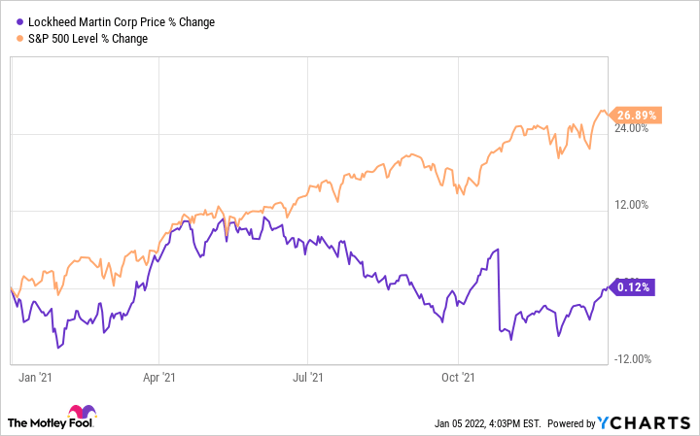What happened
In a year when the S&P 500 soared higher, Lockheed Martin (NYSE: LMT) was stuck in a holding pattern. The aerospace giant's shares were flat in 2021, according to data provided by S&P Global Market Intelligence, losing to the index by more than 26 percentage points.
LMT vs. S&P 500 data by YCharts
So what
Investors had high hopes for defense stocks heading into 2021, with optimism that the sector could recover after a weak 2020 during which share prices were held back by election-year uncertainty. And indeed, in the first few months of the year, Lockheed Martin's stock performance nearly matched the S&P 500, fueled by a favorable Pentagon budget request and buoyed by the uneasy relations between the U.S. and both China and Russia.
But headwinds emerged mid-year. The Afghanistan withdrawal occupied the Pentagon's attention, delaying some contract awards, and continued pandemic-related issues stressed supply chains and pushed back scheduled deliveries. Lockheed Martin disappointed investors with October guidance that predicted anemic growth in 2022, pushing the stock temporarily into the red for the year.

Lockheed Martin's F-35 in flight. Image source: Lockheed Martin.
The company faces internal issues in addition to the external headwinds. Its planned acquisition of Aerojet Rocketdyne Holdings, which would bolster its space portfolio, has been pushed into 2022 due to regulatory concerns. And revenues from some of its legacy programs could dry up faster than new programs can replace them.
Lockheed Martin hopes to induce investors to stick around through the rough patch by boosting its returns to shareholders; it has earmarked a large portion of the $15 billion in free cash flow it expects to generate in the years to come for dividends and buybacks.
Now what
Lockheed Martin's management was clear they do not expect a quick growth turnaround in 2022, and without one, the stock could remain temporarily stuck in the doldrums. But for a long-term investor, there is a lot to like about Lockheed Martin's prospects over the next decade.
The company is a world leader in hypersonics, a key Pentagon priority that should produce billions in government spending through the rest of the decade, and it's a finalist in a number of competitions, including two massive Army helicopter programs and in missile defense. It is also rumored to be working with the Air Force on a new fighter.
It will be 2023 at the earliest before we see real revenue production from any of those programs, but in the meantime, investors will receive a dividend that yields 3% at current share prices for their patience.
Chances are, Lockheed Martin's stock price bottomed out after it reset expectations last autumn. But until the growth returns, this is mostly a stock for income-focused investors and those with very long time horizons.
10 stocks we like better than Lockheed Martin
When our award-winning analyst team has a stock tip, it can pay to listen. After all, the newsletter they have run for over a decade, Motley Fool Stock Advisor, has tripled the market.*
They just revealed what they believe are the ten best stocks for investors to buy right now... and Lockheed Martin wasn't one of them! That's right -- they think these 10 stocks are even better buys.
*Stock Advisor returns as of December 16, 2021
Lou Whiteman owns Lockheed Martin. The Motley Fool recommends Lockheed Martin. The Motley Fool has a disclosure policy.
The views and opinions expressed herein are the views and opinions of the author and do not necessarily reflect those of Nasdaq, Inc.



